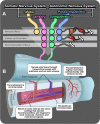Role of the Peripheral Nervous System in Skeletal Development and Regeneration: Controversies and Clinical Implications
- PMID: 37578676
- PMCID: PMC10543521
- DOI: 10.1007/s11914-023-00815-5
Role of the Peripheral Nervous System in Skeletal Development and Regeneration: Controversies and Clinical Implications
Abstract
Purpose of review: This review examines the diverse functional relationships that exist between the peripheral nervous system (PNS) and bone, including key advances over the past century that inform our efforts to translate these discoveries for skeletal repair.
Recent findings: The innervation of the bone during development, homeostasis, and regeneration is highly patterned. Consistent with this, there have been nearly 100 studies over the past century that have used denervation approaches to isolate the effects of the different branches of the PNS on the bone. Overall, a common theme of balance emerges whereby an orchestration of both local and systemic neural functions must align to promote optimal skeletal repair while limiting negative consequences such as pain. An improved understanding of the functional bidirectional pathways linking the PNS and bone has important implications for skeletal development and regeneration. Clinical advances over the next century will necessitate a rigorous identification of the mechanisms underlying these effects that is cautious not to oversimplify the in vivo condition in diverse states of health and disease.
Keywords: Bone regeneration; Denervation; Fracture healing; NGF/TrkA; Peripheral nerve; Skeletal development.
© 2023. The Author(s).
Conflict of interest statement
The authors declare no competing interests.
Figures


Similar articles
-
Targeting the central and peripheral nervous system to regulate bone homeostasis: mechanisms and potential therapies.Mil Med Res. 2025 Mar 20;12(1):13. doi: 10.1186/s40779-025-00600-8. Mil Med Res. 2025. PMID: 40108680 Free PMC article. Review.
-
Function of peripheral nerves in the development and healing of tendon and bone.Semin Cell Dev Biol. 2022 Mar;123:48-56. doi: 10.1016/j.semcdb.2021.05.001. Epub 2021 May 13. Semin Cell Dev Biol. 2022. PMID: 33994302 Free PMC article. Review.
-
Hallmarks of peripheral nerve function in bone regeneration.Bone Res. 2023 Jan 5;11(1):6. doi: 10.1038/s41413-022-00240-x. Bone Res. 2023. PMID: 36599828 Free PMC article. Review.
-
Ultrastructure and cellular biology of nerve regeneration.J Reconstr Microsurg. 1998 Aug;14(6):423-36. doi: 10.1055/s-2007-1000203. J Reconstr Microsurg. 1998. PMID: 9734847 Review.
-
Emerging roles of nerve-bone axis in modulating skeletal system.Med Res Rev. 2024 Jul;44(4):1867-1903. doi: 10.1002/med.22031. Epub 2024 Feb 29. Med Res Rev. 2024. PMID: 38421080 Review.
Cited by
-
The effect of prenatal fumonisin B exposure on bone innervation in newborn Wistar rats.J Vet Res. 2024 Oct 9;68(4):633-642. doi: 10.2478/jvetres-2024-0056. eCollection 2024 Dec. J Vet Res. 2024. PMID: 39776677 Free PMC article.
-
Sarm1 knockout prevents type 1 diabetic bone disease in females independent of neuropathy.JCI Insight. 2024 Jan 4;9(4):e175159. doi: 10.1172/jci.insight.175159. JCI Insight. 2024. PMID: 38175722 Free PMC article.
-
Spatial histomorphometry reveals that local peripheral nerves modulate but are not required for skeletal adaptation to applied load in mice.JBMR Plus. 2025 Jan 12;9(3):ziaf006. doi: 10.1093/jbmrpl/ziaf006. eCollection 2025 Mar. JBMR Plus. 2025. PMID: 40040837 Free PMC article.
References
-
- Castañeda-Corral G, Jimenez-Andrade JM, Bloom AP, Taylor RN, Mantyh WG, Kaczmarska MJ, et al. The majority of myelinated and unmyelinated sensory nerve fibers that innervate bone express the tropomyosin receptor kinase A. Neuroscience. 2011;178:196–207. doi: 10.1016/j.neuroscience.2011.01.039. - DOI - PMC - PubMed
Publication types
MeSH terms
Grants and funding
LinkOut - more resources
Full Text Sources
Research Materials
Miscellaneous

